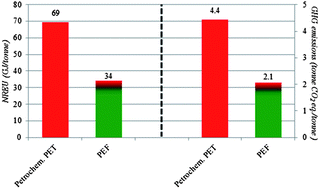An energy and greenhouse gas (GHG) balance study was performed on the production of the bioplastic polyethylene furandicarboxylate (PEF) starting from corn based fructose. The goal of the study was to analyze and to translate experimental data on the catalytic dehydration of fructose to a simulation model, using the ASPEN Plus modeling software. The mass and energy balances of the simulation model results were then used as inputs for a process chain analysis (by application of the life cycle assessment methodology, LCA) and compared to its petrochemical counterpart polyethylene terephthalate (PET). The production of PEF can be divided into three main units: the production of fructose from corn starch; the conversion of fructose into Furanics and subsequent recovery and upgrading; and the oxidation to the monomer 2,5-furandicarboxylic acid (FDCA) and polymerization with ethylene glycol (EG) into PEF. The ASPEN Plus simulation model describes the conversion of fructose into Furanics, subsequent recovery and upgrading and a CHP unit. The production of fructose from corn starch and the oxidation and polymerization into PEF were based on the literature. In total, six model cases were analyzed, using different sets of underlying experimental data; four cases based on crystalline fructose and two cases on high fructose corn syrup (HFCS). Fructose can be converted into Furanics at efficiencies between 38% and 47%. The production of PEF can reduce the NREU approximately 40% to 50% while GHG emissions can be reduced approximately 45% to 55%, compared to PET for the system cradle to grave. These reductions are higher than for other biobased plastics, such as polylactic acid (PLA) or polyethylene (PE). With an annual market size of approximately 15 million metric tonnes (Mt) of PET bottles produced worldwide, the complete bottle substitution of PEF for PET would allow us to save between 440 and 520 PJ of non-renewable energy use (NREU) and to reduce GHG emissions by 20 to 35 Mt of CO2 equivalents. If also substantial substitution takes place in the PET fibres and film industry, the savings increase accordingly. The GHG emissions could be further reduced by a switch to lignocellulosic feedstocks, such as straw, but this requires additional research.

You have access to this article
 Please wait while we load your content...
Something went wrong. Try again?
Please wait while we load your content...
Something went wrong. Try again?


 Please wait while we load your content...
Please wait while we load your content...